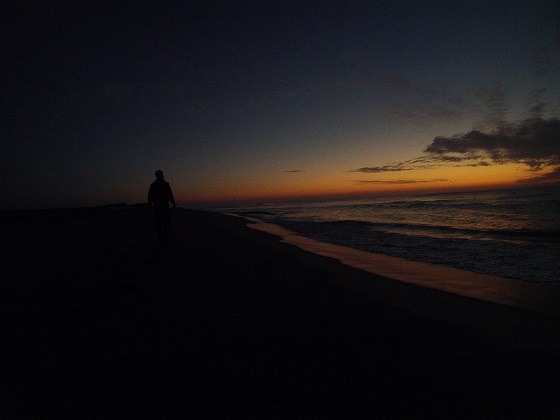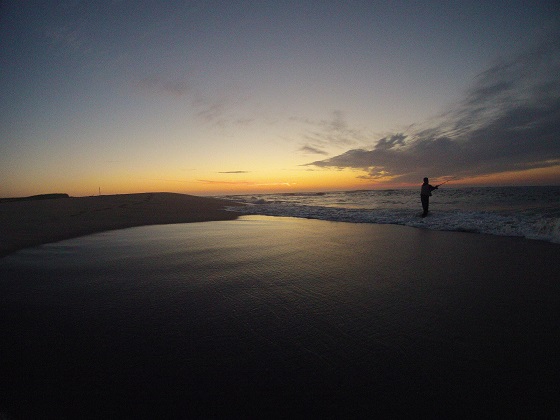Fishing Cape Cod's National Seashore is a wild and rugged experience. Oceanic waves relentlessly crash on more than 40 miles of pristine glacial sand. The great beaches of Outer Cape Cod extend all the way from Chatham to Provincetown-virtually as far as the eye can see.
An angler standing on the great back beach looking eastward is greeted by the enormity of the Atlantic Ocean and all its power. During winter storms seas in this area can grow to astounding heights of more than 30 feet. At high tide waves crest and tear into the coastline, shifting dunes, moving sandbars and sweeping pieces of Cape Cod back into the Atlantic.
Unlike stonewalled and jetty-ridden beaches, permanence on Cape Cod's National Seashore does not exist. The beach changes by the season, by the month and sometimes by the day. The winter of 2013 altered some sections of Outer Cape beaches so drastically, it rendered them unrecognizable.
The fishing, like the terrain, is also ever changing. Striped bass come and go with the tides and daylight. They cruise through crystal clear turquoise water in search of prey. Differences in the shoreline, like cuts in sandbars, beckon them to remain in one spot long enough for an angler to catch them. Then without warning they disappear again, back into the cool Atlantic.
Fishing the National Seashore is the most scenic, vast and challenging striped bass fishing adventure Cape Cod has to offer.
Surfcasting the Back Beaches of Cape Cod
The one thing you will not find this time of the year on the back beaches of Cape Cod are crowds. Unlike easy to access fishing hot spots like the Cape Cod Canal, the great back beaches are often devoid of human life. Many trips will produce more great blue heron sightings than other people. If you are looking for solitude, then this is the spot for you.
Through the centuries solitude has attracted many fishermen, writers and outdoor enthusiasts to the back beaches. Writer Henry Beston, who in 1927 spent a solitary year in the dunes, said it best:
"Listen to the surf, really lend it your ears, and you will hear in it a world of sounds: hollow boomings and heavy roarings, great watery tumblings and tramplings, long hissing seethes, sharp, rifle-shot reports, splashes, whispers, the grinding undertone of stones, and sometimes vocal sounds that might be the half-heard talk of people in the sea.”
Spend a night or false dawn fishing an Outer Cape beach and you too will feel a little of what Beston is alluding to. It is impossible not to, granted you fish the beach with all you got. Long treks by foot or over sand vehicle are necessary in order to find the bite. Throughout your search for stripers, the one constant are the rife shots, trumblings and hollow boomings that Beston so perfectly captures.
Finding Stripers Along the Back Beach
I knew I had my work cut out for me this morning when my alarm sounded at 3:15AM. With zero intel and no reliable fishing reports, I felt like a college freshman, heading off to some faraway school with no idea of what I was getting myself into. But just like the college freshman, I was excited to see what was in store for me along the back beaches of Cape Cod.
My plan was simple. I was going to hit the beach before sunrise, start walking and never stop casting. I had no idea where the fish were, but I did have two strong legs and some new braided line that had to be broken in. At 4:50AM I tossed my first cast into the Atlantic.
I believe Outer Cape Cod surfcasting legend Frank Daignult said that 100 casts into a well read section of the beach, will outproduce 1,000 blind casts 100% of the time. Pure hardwork and grindstone fishing can only take you so far when striped bass fishing Outer Cape Cod.
The smarter choice is to learn how to read the beach, the surf, and process how striped bass will react to a given area. Ask yourself, what is it about this section of beach a bass would find attractive? If I were a fish, would I stop here, or just swim on by?
A general rule of thumb is to remember that stripers are attracted to things that are different. If along a 10 mile stretch of sandy beach there is but one area of rock, then that spot will at some point catch the attention of a passing school of fish. A bend in the shoreline, when the previous 5 miles were straight as an arrow warrants extra attention. Fish will not always be present in these spots, but there is a good chance they will be.
I kept this in the back of my mind as I fired another cast into a cut between sandbars. I started my retrieve as the sun began to peek over the horizon. There were terns diving after small sand eels in shallow, and larger gannets dive bombing bigger bait out beyond the breakers.
The stage was set for a memorable morning of fishing.





